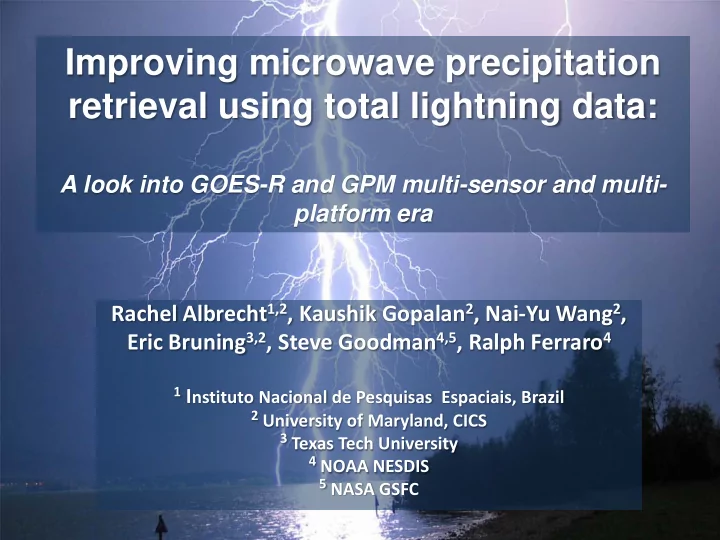

Improving microwave precipitation retrieval using total lightning data: A look into GOES-R and GPM multi-sensor and multi- platform era Rachel Albrecht 1,2 , Kaushik Gopalan 2 , Nai-Yu Wang 2 , Eric Bruning 3,2 , Steve Goodman 4,5 , Ralph Ferraro 4 1 I nstituto Nacional de Pesquisas Espaciais, Brazil 2 University of Maryland, CICS 3 Texas Tech University 4 NOAA NESDIS 5 NASA GSFC
Lightning and Passive Microwave – Blyth et al. (2001), Petersen et al. (2005) and Latham et al. (2007): • ice-scattering is a prerequisite lightning – Nesbitt et al. (2001) and Blyth et al. (2001) • thunderstorms with high lightning frequency have the most pronounced scattering signals, and there is a log-linear relationship between lightning optical groups and Tb 85 and 37 GHz. – Boccippio (2005) and Boccippio et al. (2005): • trained a neural network of simultaneous Z(PR) profiles, TMI and LIS, and classified in Convective–C, Stratiform–S, and Mixed–M); • combined TMI and LIS to retrieve PR rain, improving in 10% the retrieval of convective precipitation. • combination of IWP (retrieved from TMI) and lightning occurrence within 15 km from the center of the column cloud separated the “ambiguous” midlevel convective/stratiform cluster pairs in their lightning probabilities.
Boccippio et al. (2005)
There is a physical relationship between lightning and MW: • – Both are reflection of ice signatures Rain rate estimation using Infrared (IR) channels and cloud-to- • ground (CG) lightning: – Grecu et al. (2000) showed a reduction of about 15% in the root-mean- square error of the estimates of rain volumes from IR data defined by convective areas associated by lightning. – Morales and Anagnostou (2003) showed that the incorporation of CGs in the rainfall type segregation ~8% the rain accumulation and 31% in the rain area when estimating rain rates from IR. – Chronis et al. (2004) found a 93% reduction in the root mean square error (RMS) for rain rates at 1 o horizontal resolution and 78% at 5 o .
TMI version 7 rain rate algorithm 2A12 (Gopalan et al., 2010) • Heuristic method that artificially removed pixels with high disagreement between RR TMIv6 and RR PR : • 1) Re move RRTMIv6 >1.50 RR PR from the convective training (P(C) PR >= 0.75) • 2) Remove RR TMIv6 <0.50 RRPR from the stratiform training (P(C) PR = 0) • 3) Adjust a curve to RR PR and T85V for convective and stratiform RR • 4) Find a P(C) v7 probability of distribution that matches the PR convective fraction (CF).
• However, the TMI P(Conv) version 7 (Gopalan et al., 2010) is purely heuristic. • Therefore, our objective is to take advantage of this physical relationship between MW and lightning to improve the partition between Convective and Stratiform precipitation: • Insert lightning parameters measured by TRMM LIS into TMI convective portion equation following McCollum and Ferraro (2003) :
GOES-R and GPM • GOES-R rain rate algorithm is Self-Calibrating Multivariate Precipitation Retrieval (SCaMPR) (Kuligowski, 2002) – an effort to combine the relative strengths of infrared (IR)- based and microwave (MW)-based estimates of precipitation. – uses GOES IR data as a source of predictor information and calibrates them against MW-based rain rates • SCaMPR will be calibrated against GMI, and total lightning measurements will be made by GOES-R Geostationary Lightning Mapper (GLM). • Moreover, NOAA new focus is on multi-sensor and multi- platform algorithms (sensors and platforms complete each other)
• We propose to use total lightning to help Passive Microwave on Convective/Stratiform partition: SCaMPR – GMI proxy data → TRMM Microwave Imager (TMI) – GLM proxy data → TRMM Lightning Imaging Sensor (LIS ) • Improving MW rain rate we improve SCaMPR calibration.
Data (proxies TMI and LIS) • University of Utah Precipitation Feature database ( http://trmm.chpc.utah.edu/ ) (Liu et al., 2008) collocated with several LIS ( http://thunder.msfc.nasa.gov/) parameters: » flashes » groups » events
Preliminary results TMI CPI = A (STDEV) + B (T10V) + C (NPOL) + D (PIWD) + E (POL) + F (T37V) + G (T85V) + H (LIGHTNING PARAMETERS) + I Stratiform Convective All • Clearly the presence of lightning is prominent in convective rain: • 10% RMS error improvement in microwave convective rain identification when using lightning data • Virtually no improvement from lightning in C/S in startiform rain • Overall (all rain) 5% error reduction in microwave C/S identification with lightning data
• All lightning parameters improve P(Conv) for P(Conv) >= 0.3 (Convective) and P(Conv)=0 (purely Stratiform) compared to TMI v7. • But it worsen P(Conv) for 0.3 < P(Conv) < 0 compared to TMI v7.
Conclusions Preliminary analysis indicated that lighting data can help microwave • convective/stratiform partition, especially over convective rain regime (10% convective, 5% overall) As expected, the method did not work well over the stratiform • region. Work in progress to identify stratiform features in the some lightning derived parameters, for example, lightning “centroid” and “extent” density, flashes within 15 km, etc.: – Lightning “centroid” and “extent” are related to the ice-phase microphysical precursors to lightning, and may therefore have explanatory power in precipitation estimation settings. – Flash initiation rate (“centroid”) is related to the recharging rate of a local electric field. This happens most readily where active inter-hydrometeor charge separation is taking place, i.e., in deep convective cores where updrafts are providing abundant supercooled water and hydrometeor growth. – The “extent” of flash propagation indicates the extent of charged regions defined primarily by advective processes that redistribute the charged precipitation formed in the storm updraft.
Recommend
More recommend